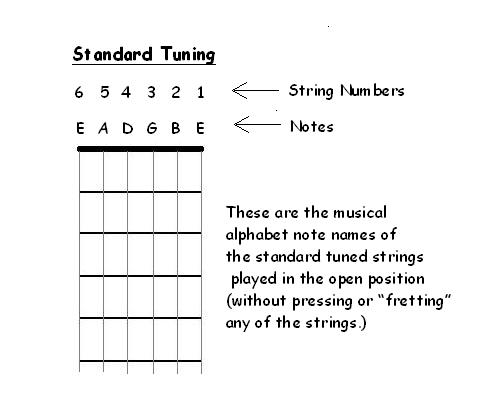
Welcome to FreeGuitarCourse.com!
For Sitemap click the underlined FreeGuitarCourse.com logo above.
Join our free newsletter for site updates, tips, & tricks!
Standard Guitar Tuning
OK, this stuff about the musical alphabet probably doesn’t mean much to you just yet, but keep moving and it will begin to clear up soon. We need to get your guitar tuned properly and then we will be ready to tackle some beginning hands-on stuff. Remember that the basic musical alphabet consists of seven pitches or tones, identified by the letters A-B-C-D-E-F-G. You might expect that the strings would be tuned in this order, but that is not the case. The guitar is tuned to allow for the easiest finger positions for a wide range of chords and scales. Again, you will understand this better as you progress, just take it in for now and let it soak as you continue.
The standard guitar tuning is E-A-D-G-B-E. If you will hold the guitar in front of you, the front of the guitar facing you, with the wide bottom resting on the floor, you will be looking at six strings. The leftmost string must be tuned to E. In other words, if you pluck this string open (without holding down on any of the frets) it will sound out in the pitch we call E. The next string to the right is tuned to A. The next string is tuned to D, and so on.

So you're sitting there with your guitar, ready to tune, and the next step is to start turning the keys and bringing the strings into the right tune. So how do you recognize an E note? Well, there are several possible ways, but the easiest way for a beginner is to take it to a friend or guitar shop and have it tuned for you. The next best approach is to use an electronic guitar tuner with automatic pitch recognition. You can get one of these at any place that sells guitars or from one of our supporting sponsors. It should cost from $20 to $90 for a hand held or clip-on model (electric or acoutic guitars), or around $80 to $100 for the foot pedal type (electric guitars only) and will include instructions on tuning your guitar correctly. You may also try using the sound file link below, but you will need to have some ability to discern pitches to use this method. You will develop this kind of discernment soon, but for now you may do best to try one of the other methods.
Click here to hear the sound of standard tuning on the acoustic guitar.
